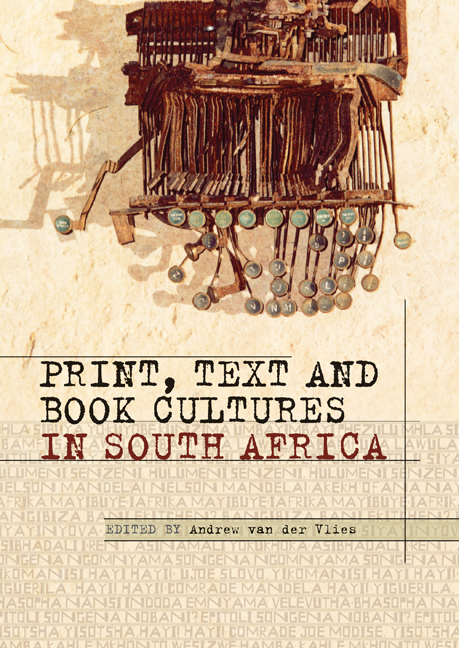Book contents
- Frontmatter
- Contents
- Acknowledgements
- Abbreviations and acronyms
- 1 Introductory
- 2 Print Cultures and Colonial Public Spheres
- 3 Local/Global: South African Writing and Global Imaginaries
- 4 Three Ways of Looking at Coetzee
- 5 Questions of the Archive and the Uses of Books
- 6 Orature, Image, Text
- 7 Ideological Exigencies and the Fates of Books
- 7.1 The Politics of Obscenity: Lady Chatterley's Lover and the Apartheid State
- 7.2 “Deeply Racist, Superior and Patronising”: South African Literature Education and the “Gordimer Incident”
- 7.3 Begging the Questions: Producing Shakespeare for Post-apartheid South African Schools
- 8 New Directions
- Contributors
- Index
7.1 The Politics of Obscenity: Lady Chatterley's Lover and the Apartheid State
from 7 - Ideological Exigencies and the Fates of Books
Published online by Cambridge University Press: 21 April 2018
- Frontmatter
- Contents
- Acknowledgements
- Abbreviations and acronyms
- 1 Introductory
- 2 Print Cultures and Colonial Public Spheres
- 3 Local/Global: South African Writing and Global Imaginaries
- 4 Three Ways of Looking at Coetzee
- 5 Questions of the Archive and the Uses of Books
- 6 Orature, Image, Text
- 7 Ideological Exigencies and the Fates of Books
- 7.1 The Politics of Obscenity: Lady Chatterley's Lover and the Apartheid State
- 7.2 “Deeply Racist, Superior and Patronising”: South African Literature Education and the “Gordimer Incident”
- 7.3 Begging the Questions: Producing Shakespeare for Post-apartheid South African Schools
- 8 New Directions
- Contributors
- Index
Summary
“Why shouldn't we go to South Africa?”
“We might!”, he said slowly.
D. H. Lawrence, Lady Chatterley's Lover (1928; 1993, 215–16).In late 1928 various factors—piracy, a hostile press, and confiscations by US customs and Scotland Yard—forced D. H. Lawrence to become the first major defender of Lady Chatterley's Lover. In a series of prose pieces published in or around 1929—“Pornography and obscenity”, the introduction to These Paintings, the introduction to Pansies, and the A Propos—he rejected the charge that he was a pornographer and that his novel was, as John Bull had put it, an “evil outpouring” (Lawrence 1993, xxxii). Decrying pornography as the “attempt to insult sex, to do dirt on it”, he presented himself variously (and at times contradictorily) as a physician out to heal the “diseased” modern psyche; as a truth teller seeking to expose the “sentimental lie of purity and the dirty little secret”; as a champion of an enlightened modernity that had left behind the “dim-minded, obscure, violent natures of the Middle ages”; as a defiant individualist up against the “mob, mob, mob” and its “obscene howl”; and as a purifier of the dialect of the tribe who wished to cleanse the word “arse” of its deforming “mental associations” (Lawrence 1998, 286, 294–314; 1993, 307). For good measure, he also added paeans to the Old Church (it “knew best the enduring needs of man”) and to Christian marriage (which has “given man the best of his freedom, given him his little kingdom of his own within the big kingdom of the State”) (Lawrence 1993, 321–22). Although unorthodox, his social attitudes, religious feelings, intentions and hoped-for effects were, Lawrence urged, serious, sincere and high-minded. Lady Chatterley's Lover was “an honest, healthy book, necessary for us today” (Lawrence 1993, 307).
For 30 years public authorities around the world (the “grey ones” as Lawrence dubbed them) did not believe him (Lawrence 1998, 303).
- Type
- Chapter
- Information
- Print, Text and Book Cultures in South Africa , pp. 348 - 368Publisher: Wits University PressPrint publication year: 2012

